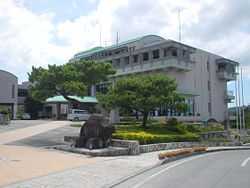Ginoza, Okinawa
| Ginoza Okinawan: Jinuza | |||
|---|---|---|---|
| Village | |||
| 宜野座村 | |||
 | |||
| |||
 | |||
 Ginoza | |||
| Coordinates: 26°28′54″N 127°58′32″E / 26.48167°N 127.97556°ECoordinates: 26°28′54″N 127°58′32″E / 26.48167°N 127.97556°E | |||
| Country | Japan | ||
| Region | Kyushu | ||
| Prefecture | Okinawa Prefecture | ||
| District | Kunigami | ||
| Government | |||
| • Mayor | Atsushi Tōma | ||
| Area | |||
| • Total | 31.28 km2 (12.08 sq mi) | ||
| Population (May 1, 2013) | |||
| • Total | 5,544 | ||
| • Density | 180/km2 (460/sq mi) | ||
| Time zone | Japan Standard Time (UTC+9) | ||
| - Tree | Ryūkyū pine | ||
| - Flower | Rhododendron | ||
| - Bird | Japanese White-eye | ||
| Phone number | 098-968-5111 | ||
| Address |
296 Ginoza Ginoza, Kunigami-gun Okinawa Prefecture 904-1392 | ||
| Website | www.vill.ginoza.okinawa.jp(Japanese) | ||
Ginoza (宜野座村 Ginoza-son, Okinawan: Jinuza[1]) is a village located in Kunigami District, Okinawa Prefecture, Japan.
As of 2013 the village had a population of 5,544 and a population density of 180 persons per km². The total area of Ginoza is 31.28 square kilometres (12.08 sq mi), and 50% of the land area of the village is used for United States military bases.[1][2][3]
Etymology
The kanji for Ginoza (宜野座) mean "suitable field in which to sit".
Geography
Ginoza is located on the eastern coast of the middle of the island of Okinawa. The village is located on the backbone of mountains that run north to south on Okinawa Island, and slopes gently to a broad coastline along the Pacific Ocean.[1] The Kanna Dam was completed in 1993.
Neighboring municipalities
Ginoza borders three municipalities in Okinawa Prefecture.
Districts
Ginoza is divided into four districts.
- Kanna (漢那)
- Ginoza (宜野座)
- Sokei (惣慶)
- Matsuda (松田)
History
The area of present-day Ginoza was historically agricultural. The area was, however, used as a retreat for members of the artistocratic class of Shuri, Naha, Toumai (Tomari); consequently, the area was strongly influenced, economic and culturally, by the central Ryukyuan state. In a census of Ginoza in 1903 half the town was registered as nobility, and half as commoners.[2]
Ginoza became part of Okinawa Prefecture with its creation in 1879, and part of Kunigami District in 1896. In the administrative reorganization of Okinawa Prefecture in 1908 the Kinmu magiri was divided into two villages; the majority of the former magiri became Ginoza, and a small part was added to the present-day town of Kin.[2] A large part of the population of Ginoza emigrated overseas before World War II.[1]
During World War 2 Ginoza village's schools were used as field hospitals. Bodies lie buried around the buildings to this day. Directly after the war Ginoza the south central part of Ginoza was home to a large concentration of refugees. The population of the village reached over 100,000, and the village was temporarily divided into six cities. The population of the village dropped rapidly after this period as Okinawans returned to their home villages.[1] 50% of Ginoza remains occupied by United States military bases.[1]
Culture
The Ginoza Village Museum opened in 1994.
Economy
Agricultural production remains high in Ginoza. Like other areas of Okinawa, the village produces sugarcane. Cut flowers production, which has spread rapidly to other municipalities in Okinawa Prefeture, has also been developed in Ginoza. The village produces of chrysanthemums and orchids. Tropical fruit, specifically pineapples and mangoes, is also a developing part of the agricultural sector Ginoza. Additionally potatoes are grown in Ginozan.[1]
Rent from land used for military bases by the United States remains a large source of income in the Ginoza. The village government has attempted to diversify the economy of Ginoza, but dependence on rental income remains high.[2]
Government
Under the Local Autonomy Law of 1947 the government of Ginoza consists of an elected village council, an elected mayor, and administrative committees and departments under control of the mayor. Ginoza, with a population of under 2,000 residents, has a village council consisting of 12 members. Members of the council and the mayor serve a four year term. The mayor of Ginoza is Atsushi Tōma.[4]
Education
Ginoza operates three elementary schools (Matsuda, Kinna, and Ginoza Elementary Schools) and one junior high school (Ginoza Junior High School). The Okinawa Prefectural Board of Education operates Ginoza High School.
Transportation
Road
Ginoza is crossed by Japan National Route 329, national highway which connects Nago, Okinawa and Naha, Okinawa, and the Okinawa Expressway. The Ginoza Interchange connects JNR 329 and the Okinawan Expressway.[1]
References
- ↑ 1.0 1.1 1.2 1.3 1.4 1.5 1.6 1.7 "宜野座(村)". Nihon Daihyakka Zensho (Nipponika) (in Japanese). Tokyo: Shogakukan. 2013. OCLC 153301537. Retrieved 2013-02-04.
- ↑ 2.0 2.1 2.2 2.3 2.4 "宜野座村" [Ginoza]. Nihon Rekishi Chimei Taikei (in Japanese). Tokyo: Shogakukan. 2013. OCLC 173191044. Retrieved 2013-06-21.
- ↑ "宜野座村基本情報(平成24年8月末現在)" [Basic Information on the Village of Ginoza (August 2012)] (in Japanese). Ginoza, Okinawa Prefecture, Japan: Village of Ginoza. 2012. Retrieved 2013-02-04.
- ↑ "村議会" [Village Council] (in Japanese). Ginoza, Okinawa Prefecture, Japan: Village of Ginoza. 2012. Retrieved 2013-05-29.
External links
![]() Media related to Ginoza, Okinawa at Wikimedia Commons
Media related to Ginoza, Okinawa at Wikimedia Commons
- Ginoza official website (Japanese)

